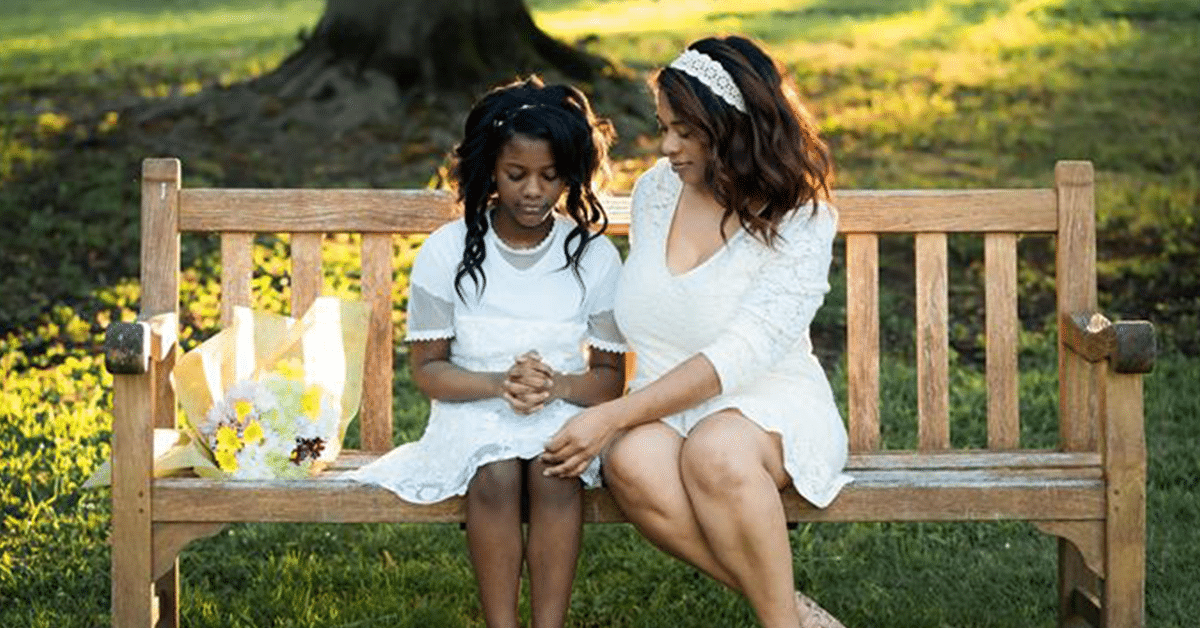It’s 6pm on a Saturday, and we’ve arrived on a sun-drenched restaurant patio with friends we’re hosting for the weekend. Birds are chirping. Soft guitar music is playing. A faint smell of lilies and hydrangeas sweetens the air. All around us, restaurant patrons are smiling, laughing, merrily clinking beer glasses.
My toddler is screaming.
He does not want to play with bubbles. He does not want to eat chicken fingers or cheddar bunnies. He does not want to see mom’s and dad’s friends. He wants to go home.
I take him for a walk around the block. The screaming continues. He does not want to see the flowers. He does not want to take a deep breath (should have seen that one coming).
He does not, under any circumstances, want to check out the equipment in that landscaping truck. The situation is more dire than I realized.
As he grows increasingly inconsolable, my heart rate rises. I’m sweating. My teeth are clenching.
There’s a faint, pregnancy-induced throbbing in my lower back. I have to pee. We walked to dinner, so home is a solid 20 minutes away.
Do I dare re-enter the restaurant? Try another snack? Another toy? Another walk around the block? My husband offers to take over, but he was the one to deal with last night’s meltdown, and one of us needs to stay with our guests—so some combination of guilt, determination, and my growing fight-or-flight response makes me decide this is my problem alone to solve.
We’ve got 99 problems and our kids are one. (I’m sorry. I’ll see myself out.)
Here’s a thing no one told me about parenting: you end up running into a surprising number of problems. Often they’re small, like: my toddler is melting down. Or, I want to host friends for the weekend, but I also want my child not to scream in their faces.
Sometimes the problems are bigger. Your child is being bullied at school. Or, you’re feeling overwhelmed and lacking the support you need as a new parent. Or, you and your partner disagree on how to handle your child’s behavior.
And here’s the crazy part of all those parenting problems: you need to try to solve them. I know! Honestly, so unfair.
Amidst my newfound parenting problems, I’ve found myself often falling back on an evidence-based approach I learned as a therapist training in Dialectical Behavior Therapy (DBT). It’s called 4 Ways to Solve a Problem, and it seems simple—maybe too simple—but that’s kind of the point. There’s value in taking a moment to pause, carefully put down the bubbles and cheddar bunnies, and actively decide what to do.
I hope it helps you, too.
4 Ways to Solve a Problem
For any problem you encounter—parenting or otherwise—you’ve got four options for how to deal with it:
- Solve the problem
- Change how you feel about the problem
- Radically accept the problem
- Stay miserable (and/or make it worse)
Sometimes, a combination of these options is best. Sometimes, you’ll try one of the options, discover it’s not working, and move on to another, instead.
Let’s walk through them.
Option 1: Solve the problem
I know, I know. If you already knew how to solve the problem, wouldn’t you have done it already? We wouldn’t be in this whole four ways to solve a problem mess if we could just fix it, right? But sometimes we need to be reminded of this option. It forces us to articulate both: (1) what is the actual problem, and (2) what’s the simplest possible solution.
If your child is hungry, and you have snacks, you fix the problem by feeding them snacks. If you are exhausted and sleep-deprived, and you have the option to head upstairs for a good, old-fashioned snooze, you do it. You take a minute to define the problem (kid is hungry; mom is sleep-deprived) and then you solve it.
If the problem is a bit more intractable, you might try a research-backed, problem-solving approach that goes by the acronym ABCDE: Acknowledge the problem (figure out exactly what is happening), Brainstorm solutions (name everything you can think of), Choose one solution, Do it, and then Evaluate how it went (and go back to Brainstorming if needed).
Of course, many problems aren’t so easily solvable, which is why we have a few other options.
Option 2: Change how you feel about the problem
Sometimes the problem has less to do with the situation we’re in, and more to do with how we’re thinking and feeling about it. I, like many people, have intermittent periods of encountering the following problem: I have too much on my plate. Work is too busy. I’m failing at both my parenting and my job, and everything is impossible.
Sometimes, there are actions I can take to help (e.g., reduce responsibilities, ask for help, take a little time off). Sometimes, it’s about taking a closer look at how I’m thinking and feeling.
To change how you’re thinking about the problem: Take a page out of CBT and try a bit of cognitive restructuring. Ask yourself some key questions:
- Are there other ways of thinking about the situation?
- What would I tell a friend in this situation?
- Am I 100% sure that how I’m seeing the situation is accurate?
- What evidence do I have that this is true?
In my case, I might reframe my thinking by reminding myself how exciting it is to have work opportunities I care about, and how lucky I am to have a family I want to spend time with. Or, on closer examination, I might realize I’m not totally sure about the whole failing-at-parenting-and-working thing. In fact, I have some evidence (e.g., my boss has not fired me from my job, my child has not fired me from parenting) that I’m doing okay.
To change how you’re feeling about the problem: One of my favorite strategies for changing how we feel is called opposite action. It’s the therapy version of fake it ‘til you make it, and it works like this:
- Identify the emotion you’re feeling.
- Figure out what you’d typically want to do when you have that emotion.
- Do the opposite.
If you’re feeling angry at your partner because it’s his turn to get the kids ready for bed, and when you come upstairs to say goodnight, you instead find him holding the kids by their ankles above the bed, growling and shouting I GOT YOU, while the kids, very much awake and not wearing pajamas, laugh maniacally…you might have the urge to yell. The opposite of yelling is showing kindness (Wow, you guys are having so much fun!) and/or gently walking away.
If you’re feeling scared, you might have the urge to avoid a situation. The opposite is to approach it.
If you’re feeling sad, you might have the urge to hide and stay in bed. The opposite is to get active.
And so on.
Option 3: Radically accept the problem
Before getting married, my now husband and I dated for 10 years. After a multi-year, long-distance stint brought on by one of us working in New York City and one of us falling deep into the black hole of psychology graduate training in North Carolina, we joyfully reunited, got engaged, and settled into a state of pre-wedding bliss. Eager to celebrate with the people we love, we sent out save-the-dates to an (enormous) list of all our family and friends.
This was January 2020.
A few things—well, one thing—occurred in the ensuing months that soon made it clear our original summer 2020 wedding plans were not going to happen. This was not a solvable problem. We cancelled the wedding. We disinvited all our guests. We tried to change how we felt about the problem, reminding ourselves that others were, obviously, struggling far more as they dealt with the impacts of COVID.
Ultimately, the solution that worked was to just accept the situation.
“Radical” acceptance is one of those philosophy-psychology hybrid terms that sounds much fancier than it is. The idea here is ultimately simple: accept the things we cannot change. This doesn’t mean we agree with them, or that we’re not still disappointed or angry about them. It just means that we stop blaming others or ourselves, stop feeling bad for ourselves, stop begging the universe to solve it for us, and instead, just recognize that it is.
Accepting the problem is not a one-time thing. It’s an ongoing choice that we need to make over and over again.
Sidenote: after radically accepting that the wedding we’d planned wouldn’t happen, my husband and I got married in a beautiful, much smaller, COVID-safe ceremony in late summer 2020. Celebrating our anniversary one year later with an infant in tow, we soon realized we had a lifetime ahead filled with other problems to solve—and we wouldn’t want it any other way.
Option 4: Stay miserable (and/or make it worse)
Our last option for solving a problem is really just a reminder that we have options. It’s up to us.
If we want to spend the afternoon complaining bitterly about our child’s allergist in a veiled attempt to manage our own feelings about his life-threatening yet oddly unscientific allergy diagnoses, we can do that! If we want to make things worse by calling said allergist and leaving a strongly-worded yet wholly unproductive voicemail, we can do that, too! (I recently did the former, but not [yet] the latter).
If we want to wallow in disappointment, fear, or frustration, that is our choice. The important thing is to remember we’re choosing it.
We’ve got 99 optio—no, you’re right. That’s enough.
During our most recent restaurant-pocalypse, I tried some combination of the four options. I felt sorry for myself. I tried accepting the situation. I tried reminding myself that my son was tired, and I was tired, and we were both hungry, and one of us had to pee (so badly!) because a tiny human was tap-dancing on our bladder, and these were all totally normal toddler and pregnant mom activities and feelings and…
Sapiens, I took Option 1. I turned the stroller around, and we walked straight home. Problem solved.
A fun technique I learned as a child therapist to teach deep breathing: have kids imagine “smelling the flower” (breathing in) and then “blowing out the candle” (breathing out). You can even hold up, and then put down, a finger to simulate blowing out the candle. My son’s probably still too young for this, but it hasn’t stopped me from (enthusiastically, and unsuccessfully) trying.
Okay, a quick detour into pregnancy tooth problems because I can’t help myself. Is this, actually, a thing? Like with all physical symptoms, when you Google “is my tooth pain related to being pregnant?” the Internet returns some of version of “Who knows! Maybe! Pregnancy, am I right? [wink].” I woke up a few weeks ago in enough pain that I decided (with urging, of course, from my mom) to go to the dentist for the first time in…too long. The diagnosis was that I’d been clenching my teeth—hard—in my sleep. Was I stressed? the dentist asked. I looked down at my six-month pregnant belly. I guess? I answered. The dentist suggested a nighttime mouthguard. Luckily, it nicely complements my oversized PJs and pregnancy pillow.
Worth noting that my husband and my extended families could populate a small country. So many cousins. It took us years and multiple hand-written family trees to learn all the names in each other’s families.
Keep Reading
Want more? Here are some other blog posts you might be interested in.








